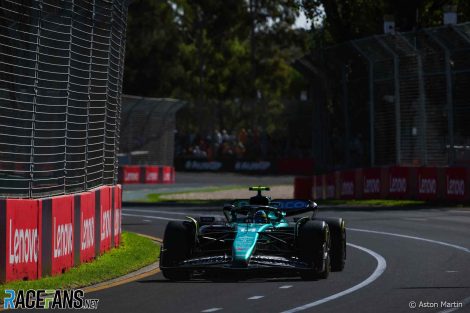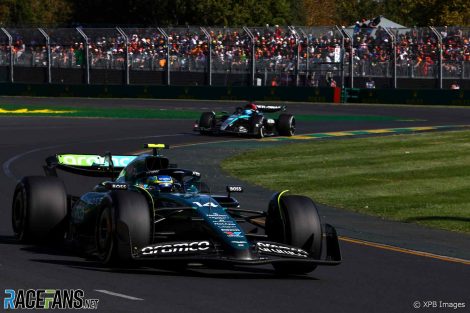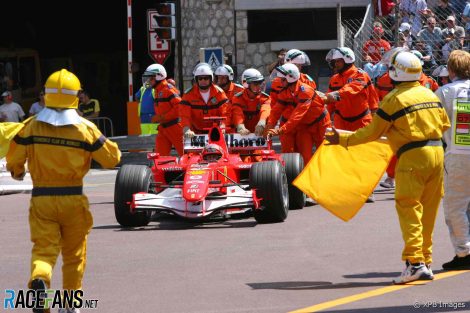Formula 1 stewards are not known for using stylistic flourishes when describing their decisions, which made document 54 of the 2024 Australian Grand Prix unusual.
They wrote a series of rhetorical questions to explain their decision to hand a post-race drive-through penalty to Fernando Alonso.
Whether or not you agreed with the call (which has proved divisive here), all sides of the debate should appreciate the stewards taking the time to explain their reasoning. It’s certainly preferable to the days when, following hours of deliberation, their decisions were announced in single-sentence statements with no accompanying explanation.
The decision was likely to provoke controversy whether it came down on Alonso’s side or that of the driver who crashed in his wake on the penultimate lap, George Russell. It appears the stewards realised that and took the time to detail why they had sanctioned a driver who had seemingly done nothing more than lift his throttle, and issued a drive-through penalty rather than the more common and less severe five- or 10-second varieties.
Alonso was given a 20-second post-race penalty for decelerating suddenly in front of Russell as they approached turn six. The pair made no contact, but the stewards called Alonso’s abrupt reduction in speed an “extraordinary” piece of driving which “was at very least ‘potentially dangerous’.”
This claim was refuted by Alonso in a press release issued by the team afterwards. “I wanted to maximise my exit speed from turn six to defend against him,” he said. “That’s what any racing driver would do, and I didn’t feel it was dangerous.”
Alonso expanded his criticism of the decision in a post shared across his social media feeds. Several of his points had been addressed by the stewards in their 557-word decision two hours earlier.
No crash, no investigation?
As far as Alonso is concerned, the stewards wouldn’t have bothered to look into his approach to the corner had Russell not crashed. The Mercedes driver lost control in Alonso’s wake as he arrived at the bend suddenly much closer to the Aston Martin than he anticipated.
Russell ran wide onto the gravel, then hit a barrier. Had the corner been bordered with asphalt, as many in F1 are, he may have been able to avoid crashing. “I believe that without gravel on that corner, on any other corner in the world we will never be even investigated,” Alonso wrote.
The stewards, whose inquiry was prompted by a report from race director Niels Wittich, denied the crash was a factor. Their report stated they “have not considered the consequences of the crash” and that their focus was on “the situation that occurred prior to the crash.”
Advert | Become a RaceFans supporter and
Telling drivers how to drive

Alonso also took issue with the stewards ruling on “how we should approach the corners or how we should drive the race cars.”
He claimed he slowed down on his approach to the corner in order to improve his exit from it and defend his position from Russell. “Sacrificing entry speed to have good exits from corners is part of the art of motorsport,” he said.
This is no doubt true and we see it all the time. But the stewards said they were not challenging whether drivers have a right to perform defensive moves, or even use their car’s aerodynamic wake to disadvantage a rival.
“Should Alonso have the right to try a different approach to the corner? Yes,” they wrote. “Should Alonso be responsible for dirty air, that ultimately caused the incident? No.”
Intention
The heart of the matter, and the reason why this decision is so controversial, is the question of intention. Did Alonso cross the line between ‘legitimate defence’ and ‘dangerous manoeuvre’ in trying to prevent Russell from passing him?
Over the previous laps Russell had got progressively closer to passing Alonso in the DRS zones. The first detection point lay at the exit of turn six, and Alonso knew if Russell passed through it too close to him it would be almost impossible to defend his position.
“At no point do we want to do anything wrong at these speeds,” Alonso wrote. Even his strongest critics should accept that while he might have wanted to delay Russell, he was not trying to cause a crash.
Advert | Become a RaceFans supporter and
But when Alonso said he backed off approaching turn six to improve his exit from the corner, the stewards said it was “extraordinary” how early and how much he had slowed down by:

“Telemetry shows that Alonso lifted slightly more than 100m earlier than he ever had going into that corner during the race. He also braked very slightly at a point that he did not usually brake (although the amount of brake was so slight that it was not the main reason for his car slowing) and he downshifted at a point he never usually downshifted.”
Note that the stewards did not say Alonso braked 100 metres before the corner but 100 metres “earlier than he ever had”. This is an enormous amount: At Bahrain’s turn one this year drivers hit the brakes just before the 100 metre board to decelerate from over 300kph to 65kph.
While Alonso did not brake anything like as hard as that, the fact he began slowing so soon is extremely unusual. Indeed, he slowed down so much he had to speed up again: “He then upshifted again, and accelerated to the corner before lifting again to make the corner.”
It begged the obvious question why, given Alonso’s experience, if he only intended to slow down enough to improve his line for the corner, did he misjudge it so badly? Alonso’s explanation, according to the stewards, was that “while his plan was to slow earlier, he got it slightly wrong and had to take extra steps to get back up to speed.”
The stewards did not challenge that explanation in their decision, but did insert a carefully-worded sub-clause, noting he “[chose] to do something, with whatever intent, that was extraordinary.”
Advert | Become a RaceFans supporter and

This part of their decision recalls past cases where the stewards have indicated a driver’s explanation does not fully account for all the observed facts. One of the most famous cases of this was at the 2006 Monaco Grand Prix when Michael Schumacher parked up at Rascasse during qualifying – coincidentally, in an attempt to disadvantage Alonso.
Regarding Schumacher the stewards ruled there was “no justifiable reason for the driver to have braked with such undue, excessive and unusual pressure at this part of the circuit, and are therefore left with no alternatives but to conclude that the driver deliberately stopped his car on the circuit.”
While on that occasion the stewards ascribed a motive to Schumacher’s driving, they did not do the same regarding Alonso. But from their words it is clear that, in their view, if Alonso was only trying to improve his line through the corner, he did it very badly, so much so that it created a dangerous situation.
The decision raises other questions: Should drivers be allowed to slow in this way to disadvantage a rival? Should drivers who are trying to make a pass be prepared for cars ahead to slow in this way?
None of that was addressed by the stewards, as it seems Alonso did not make the case this is what he was trying to do: “The stewards considered that they do not have sufficient information to determine whether Alonso’s manoeuvre was intended to cause Russell problems, or whether as he stated to the stewards that he simply was trying to get a better exit.”
The end of the matter?
On two occasions last year Aston Martin managed to change the results of a race in their favour by raising a complaint with the stewards. But on this occasion it seems they don’t intend to take the matter any further.
Team principal Mike Krack said it was “surprising” Alonso received a penalty “but we have to accept the decision.”
But the stewards have set a notable precedent which may prove to be relevant at other races where the DRS zones are so powerful drivers will look for ways to prevent rivals benefiting from them. This may not be the last we see of this kind of controversy as drivers explore the limits of legal defensive moves.
Become a RaceFans Supporter
RaceFans is run thanks in part to the generous support of its readers. By contributing £1 per month or £12 per year (or the same in whichever currency you use) you can help cover the costs of creating, hosting and developing RaceFans today and in the future.
Become a RaceFans Supporter today and browse the site ad-free. Sign up or find out more via the links below:
Advert | Become a RaceFans supporter and
2024 Australian Grand Prix
Browse all 2024 Australian Grand Prix articles














